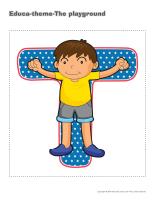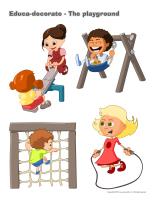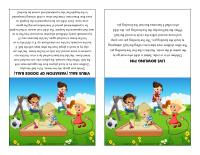AREA SETUP
(Open thematic poster-The playground) Print, laminate, and display all kinds of posters.
Educa-theme-The playground
(Open educa-theme-The playground) Print and laminate the items that represent the theme. Use them to present your theme to your group (and parents) while decorating a corner of your daycare.
Educa-decorate-The playground
(Open educa-decorate-The playground) Print, laminate, and cut out the various items. Use them to decorate your daycare and set the mood for the theme.
SPECIAL TOOL
This special tool was created in response to a special request. (Open poster-We are at the playground) Print and laminate the poster. Display it on your door or in a window whenever you visit the playground with your group.
CIRCLE TIME
Organize a special discussion period. Set your parachute on the floor, in your circle time area. Deposit different types of balls in the centre of your parachute and encourage children to name games or sports associated to each one. Fill a large bag with a variety of items such as a Frisbee, plastic shovels, etc. Take one item out of the bag at a time and invite children to tell you what it reminds them of, how they have used it in the past, etc.
PICTURE GAME
The pictures may be used as a memory game or to spark a conversation with your group. Use them to decorate your daycare or a specific thematic corner. (Open picture game-The playground) Print, laminate, and store the pictures in a Ziploc bag or in your thematic bin.
Memory game
(Open picture game-The playground) Print the pictures twice and use them to play a memory game with your group.
ACTIVITY SHEETS
(Open activity sheets-The playground) Activity sheets are suggested for each theme. Print and follow instructions.
LANGUAGE ACTIVITIES
Word flashcards
Use the cards to spark a conversation with your group or in your reading and writing area. They may also be used to identify your thematic bins. (Open word flashcards-The playground) (Open giant word flashcards-The playground) Print. swing, slide, water game, picnic table, playground structure, soccer, grass, sand, ball, Frisbee, bench, tree
Let's chat
(Open word flashcards-The playground) Print and laminate the word flashcards. Children take turns picking a flashcard and presenting the item to the group. Encourage children to share what they know about each item.
Associating words and pictures
(Open giant word flashcards-The playground) Print, laminate, and display the word flashcards on a wall in your circle time area or on a large piece of cardboard that can be moved around. Name a word and invite children to identify the corresponding word flashcard.
ROUTINES AND TRANSITIONS
My playground path
(Open transition games-The playground) Print, laminate, and set the illustrations on the floor to create a path which leads to areas frequently visited by children such as the bathroom or cloakroom. If you prefer, the illustrations may also be used to delimit your various workshops.
This is my spot-The playground
(Open transition games-The playground) Print two copies. Laminate and cut out the cards. Glue one copy of each card on the table using adhesive paper. Drop the other copies in a bag. Children take turns picking a card to determine their spot at the table for the day. You may also use the cards to determine naptime spots or for your task train.
PLAYGROUND GAME BOX
(Open playground game box) Print and laminate the cards. Each card describes a specific game that can be played at the playground, in your yard, or within your daycare. Place them inside a box that you can take with you every time you visit the playground with your group. Simply have a child pick a card to determine which game you will play.
Climb a tree
To begin, players run around a predetermined playing area. When you say, "Climb a tree or you're the cat!", children must quickly climb onto a playground structure (bench, rock, playground equipment, etc.) so their feet are no longer on the ground. The last one to succeed becomes the cat. When you give the signal, players must climb down from their "tree" and the cat must try to touch one of them. The player who is touched by the cat becomes the cat and so on. If a cat is unable to touch a player, reset the game by saying, "Climb a tree or you're the cat!" once more.
The hunter 
Divide your group into two teams. Have both teams sit facing each other, with a certain distance between them. Deposit a scarf in the centre, between both teams. Give each child from the first team a number. Attribute the same numbers to the members of the second team. Call out a number. Both children who were given this number must get up, try to grab hold of the scarf, and sit back down with their team members as quickly as possible, without getting touched by their adversary.
Musical hula hoop
In this version of musical chairs, hula hoops replace the chairs that are normally used. Use one hula hoop less than the number of children in your group. Play music. When the music stops, children must quickly find a hula hoop to stand in. To avoid being eliminated, you can allow many children to stand in the same hula hoop. Remove one hula hoop at the end of each round.
Frisbee hide-and-seek
Set three Frisbees flat on a table. Hide a tiny object under one Frisbee and move the Frisbees around several times as children watch. Have them guess which Frisbee the item is hidden under. Children can take turns pointing to the Frisbee they think the item is under. With very young children, you can hide two items under two different Frisbees to increase their chances of success.
Frisbee hopscotch
Use sidewalk chalk to draw a giant hopscotch grid on the ground outside. Children can simply toss a Frisbee on the hopscotch grid instead of using a pebble as in the traditional game.
Artistic Frisbee
For this game, you will need two Frisbees. On a grass-covered surface, children take turns stepping on both Frisbees which represent ice skates. Show them how they can execute spins and skate around the yard. This activity can also be done during winter. The Frisbees will easily glide over snow.
Spinorama
Have children stand on a start line. When you give the signal, they must spin over and over again until they reach the finish line at the opposite end of the yard.
Group tag
Select a child who will be "it". He/she must try to capture the other players. Once a child is touched, he/she must hold the hand of the child who is "it". Together, they must try to capture the others. The game continues until all the children have been caught.
Turtle tag
Tell the children in your group they are turtles. Select a child who will be "it". Every time this child touches a turtle, the child who is touched must lie on his/her back, with his/her arms and legs in the air.
Frozen tag
Select a child who will be "it". He/she must try to catch the other children. Every time he/she succeeds, the child who was touched must remain perfectly still, like a statue.
Musical statues
Invite children to dance around to the sound of fast-paced music. When the music stops, children must remain perfectly still, like statues. If a child moves, he/she must sit down until the end of the round.
Wheelbarrow race
Draw a start and finish line at opposite ends of your yard. Divide your group into teams of two children. One child from each team will be a wheelbarrow; they must get down on their hands and knees. Their hands will remain on the floor and their partner will lift their legs, holding them at knee-level. When you give the signal, they must work together to move towards the finish line. The first wheelbarrow that reaches the finish line wins.
What time is it Mr. Wolf?
Select one child who will be Mr. Wolf. He/she stands at one end of the yard, with his back to the other children who must stand on a line 20-30 feet away. When they are ready, they must ask, "What time is it Mr. Wolf?" The wolf must respond, stating a fictitious time (3:00, 6:00, etc.). The children can advance the corresponding number of steps (3 steps for 3:00, 6 steps for 6:00, etc.). Children can repeat the question several times. When the wolf feels the children are close enough, he must say, "It's time to eat you!" The children must then run away to avoid being captured. The first child who is touched by the wolf becomes the wolf for the next round.
I'm going to the market
Children sit in a circle. One child holds a small basket in his hands (real or imaginary) and says, "At the market, I bought (example: apples)." He then hands the basket to the child sitting to his left who must say, "At the market, I bought (example: apples) and (example: lettuce). He/she then hands the basket to the child to his left and so on. Each child must repeat all the items chosen by the previous children before adding one of his/her own. If a child has difficulty remembering all the items, he/she can ask the group for a clue.
Simon says
Instruct your group to perform various actions. They must execute them only if you said "Simon says" first. Suggested instructions: go to sleep, brush your teeth, wash your hands, etc. If you do not say "Simon says", children must remain perfectly still. This game can easily be adapted to your various themes and activities.
Animal families
Divide your group into three families. You can, for example, have a horse family, a sheep family, and a pig family. Whisper in each child's ear which animal family he/she belongs to. When you give the signal, children must make the corresponding animal sound to find his/her other family members. This is a very noisy activity!
Air, land, or sea
Players sit in a circle around their early childhood educator. The early childhood educator tosses a ball to a child and says "air", "land" or "sea". The child who receives the ball must catch it and throw it back to the early childhood educator while naming an animal, a person, or an object in relation to the corresponding element. For example, if the early childhood educator says "sea", the child could say "shark" or "boat". If a child cannot think of an animal, a person, or an object in relation to the element, he/she can ask the other children for suggestions to avoid elimination.
Marine monster
You will need a ball for this game. Select a child who will be the marine monster. The other children stand within the playing area to represent rocks. They mustn't move. The marine monster moves among the rocks, trying to avoid the ball that the rocks throw at him. Once the marine monster is touched, he/she becomes a rock and the child who tossed the ball at him/her becomes the next marine monster. The goal of the game is to encourage teamwork. Explain to your group how it will be easier to touch the marine monster if they pass the ball around.
Virus ball (variation of dodge ball)
Divide your group into two teams. Put a ball into play. Children must try to touch players from the opposite team with the ball. When they succeed, the player who was touched must kneel down. He/she has been touched by a virus. He/she can continue to move around, but only on his/her knees. He/she can also try to touch a player from the other team with the ball. If he/she succeeds, he/she can stand back up. If a child who is on his/her knees is touched again, he/she becomes very ill. A paramedic (early childhood educator) must escort him/her to an area that represents the hospital. The child must remain at the hospital for a predetermined period of time before joining the game once more. Each child can be transported to the hospital no more than three times. Note that when a child is being transported to the hospital he/she is protected and cannot be touched.
Live bowling pin
Children sit in a circle. Select a child who must go to the centre of the circle. He/she is the first live bowling pin. The other children must take turns rolling the ball, attempting to touch the bowling pin. The live bowling pin can jump and move around within the circle to avoid the ball. When the ball touches the live bowling pin, the child who rolled it becomes the next live bowling pin.
Prison ball
Children stand in a circle with their legs apart and their feet touching one foot of each child standing on either side of them. Put a ball into play. The goal of the game is to keep the ball inside the circle for as long as possible. Children must hit the ball with their clasped hands to prevent it from rolling between their legs.
Chasing the moon and the sun
Children sit in a circle, facing outwards. Give one child a small ball that will represent the moon. Give another child a larger ball that will represent the sun. When you give the signal, children must begin passing the moon around the circle. After a few minutes have them begin passing the sun around the circle, in the same direction. The goal of the game is for the small ball (moon) to catch up to the larger ball (sun). This game has no end. It represents a great way to keep children busy during transitions.
Traditional dodge ball
Divide your group into two equal teams. Have each team stand on opposite sides of a line drawn on the floor or ground, dividing your playing area. Toss a ball up in the air. The player who catches it will have the ball to start the game. The members of each team must try to eliminate their opponents by touching their legs with the ball. If a player is touched or crosses over the line, he/she is eliminated. The first team to eliminate all of its opponents wins.
Fast ball
Children stand in a circle with approximately an arm's length between them. Give a child a ball. As a group, they must toss the ball back and forth within the circle, in no particular order. If a child drops the ball, he/she must leave the circle. The circle will therefore get smaller and smaller as the game progresses, until there is only one child left. The last child wins the game. The children who are eliminated can form a second circle and start a new game with another ball.
Make me laugh
This game is a relaxation activity. The early childhood educator holds a ball. When she gives the signal, all the children must begin laughing. The only rule that must be respected: as soon as the ball touches the floor or ground, everyone must be perfectly silent. If a child is unable to stop laughing immediately, he/she is eliminated. Prepare for plenty of laughter!
Man in the middle
Divide your group into teams of three children. Have the children from each team stand in a line, with the two children at the opposite ends facing each other. They must throw the ball back and forth while the child in the middle tries to intercept it. When the child in the middle catches the ball, he/she changes places with the child who threw it.
Runaround ball
Divide your group into two teams. One team will throw the ball and the other team will catch the ball. The catchers must spread out within the playing area. The pitchers stand in a line. The first child in line throws the ball as far as possible. The catchers must retrieve it and bring it back to the centre of the playing area. During this time, the child who threw the ball must run around his/her teammates as quickly as possible. He/she must run around them at least once before the ball returns to avoid elimination. The child earns one point for his team for every completed trip around his teammates.
Hanging ball
You will need a beach ball and large piece of elastic fabric. Use the elastic to hang the ball from a play structure in your yard or at the playground. Children will enjoy hitting the ball, spinning it around, etc.
COLORING PAGES
(Open coloring pages theme-The playground) Print.
SONGS & RHYMES
(Open songs & rhymes-The playground)
The playground
By: Patricia Morrison Sung to: Apples and bananas
I like to play, play, play
At my favorite playground
I like to play, play, play
At my favorite playground
I like to swing, swing, swing
At my favorite playground
I like to swing, swing, swing
At my favorite playground
I like to slide, slide, slide
At my favorite playground
I like to slide, slide, slide
At my favorite playground
I like to climb, climb, climb
At my favorite playground
I like to climb, climb, climb
At my favorite playground
I like to play, play, play
At my favorite playground
I like to play, play, play
At my favorite playground
Have fun
The educatall team

 Home
Home Theme activities
Theme activities
 Babies and toddlers
Babies and toddlers
 Arts and crafts
Arts and crafts
 Science
Science
 Creative recipes
Creative recipes
 Tips and tricks
Tips and tricks
 Special needs
Special needs
 Extra activities
Extra activities
 Educ-TV
Educ-TV
 Newsletter
Newsletter  Online store
Online store Educatall club
Educatall club

